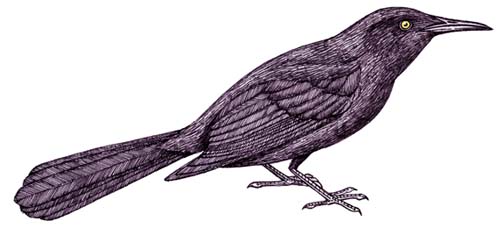

They are found from the Rocky Mountains east and from northern Canada down through the U.S. They spend the winter in the U.S.
They are found in open fields, woodlands, marshes, near homes, parks and farmlands.
They are large, dark birds with shiny (iridescent) heads. They have a long tail that widens at the end and a long thin beak.
They flock to feed on the ground, often with other kinds of birds.
They eat insects, frogs, bird's eggs, fruits, seeds, nuts, and grains.
They build a big nest of wood, leaves and grass in a small conifer tree. They line their nests with mud and grass. Females lay 1-7 pale blue-gray eggs with some spots.
Kingdom: Animalia
Phylum: Chordata
Subphylum: Vetebrata
Class: Aves
Order: Passeriformes
Family: Icteridae
Genus: Quiscalus
Species: Q. quiscula
When you research information you must cite the reference. Citing for websites is different from citing from books, magazines and periodicals. The style of citing shown here is from the MLA Style Citations (Modern Language Association).
When citing a WEBSITE the general format is as follows.
Author Last Name, First Name(s). "Title: Subtitle of Part of Web Page, if appropriate." Title: Subtitle: Section of Page if appropriate. Sponsoring/Publishing Agency, If Given. Additional significant descriptive information. Date of Electronic Publication or other Date, such as Last Updated. Day Month Year of access < URL >.
Amsel, Sheri. "Grackle (Common)" Exploring Nature Educational Resource ©2005-2024. December 13, 2024
< http://exploringnature.org/db/view/Grackle-Common >

